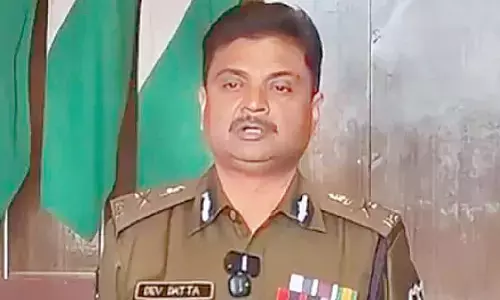Vandemataram Ramachandra Rao: A Revolutionary Hero of Telangana's Liberation Struggle

"The Son of Gadwal Ramadasu" Rises in the Freedom Struggle Earns Fame with Vande Mataram On the Occasion of Telangana Liberation Day
Gadwal: "The Son of Gadwal Ramadasu" Rises in the Freedom Struggle Earns Fame with Vande Mataram On the Occasion of Telangana Liberation Day
Born in Kyathoor, raised in Gadwal, and emerging as a prominent leader in the Nizam state’s resistance, Vande Mataram Ramachandra Rao became a figure of pride for the entire Telangana region. On the 77th anniversary of the state’s liberation from Nizam's rule and integration into India, this story revisits the life of this warrior.
Family Background
Ramachandra Rao was born on April 25, 1918, as the second child of Gadwal Ramadasu and Lakshmamma in Kyathoor village, Alampur Mandal. His father, Ramadasu, worked as a letter writer for Janakamma, the sister of the Gadwal ruler, Sitaram Bhupal. The family lived in the Kunta Street area of Gadwal. Along with his brother Veerabhadra Rao and cousin Sivashankar, Ramachandra Rao pursued his early education at the local boys' high school and later moved to Hyderabad for higher studies. In Hyderabad, he studied at the Maharani Adilakshmi Devamma Bungalow in Nampally with freedom fighter and former MLA Pagapulla Reddy. While Pagapulla Reddy joined the Congress in the Hyderabad liberation struggle, the Rao brothers supported the Hindu Mahasabha and Arya Samaj movements. Before this, Veerabhadra Rao was sent for sub-inspector training by the Gadwal estate, but he left the job to join the Hyderabad freedom struggle alongside his younger brother.
The Birth of "Vande Mataram"
In 1939, during the Satyagraha movement against the tyrannical Nizam rule, Ramachandra Rao played a key role and was imprisoned. One incident in jail changed his life. Every day, the Satyagrahis would sing "Vande Mataram." The jail superintendent prohibited this practice, but the prisoners, including Ramachandra Rao, continued. The superintendent summoned Rao and warned him, saying, "This is not your home to sing Vande Mataram as you please." To this, Ramachandra Rao boldly replied, "As long as we are here, this is our home, and we will offer prayers to our motherland after our morning prayers." Angered by this defiance, the jailer ordered 24 lashes as punishment. Rao shouted "Vande Mataram" with each lash until he fainted. From then on, people honored him with the title "Vande Mataram Ramachandra Rao," a name he carried throughout his life.
In the Hyderabad State Struggle
Rao participated in the Quit India Movement of 1942 and served jail time. He was a key figure in the people's movement that began in 1947 in Nizam's state. While working underground for some time, he gathered vital military intelligence from the Nizam's forces and passed it on to K.M. Munshi, India's agent-general in Hyderabad. The Nizam government charged him with treason, and his trials were conducted in Chanchalguda Central Jail instead of regular courts. This shows how much of a threat Rao posed to the Nizam government.
In Unified Andhra Pradesh
Ramachandra Rao contested as an independent candidate in the 1957, 1962, and 1967 general elections from the Vikarabad constituency in the erstwhile Rangareddy district and won each time. He famously exposed the corruption of two ministers, V.B. Raju and Marri Chenna Reddy, leading to the cancellation of their assembly memberships. In 1967, he defeated the then Deputy Chief Minister K.V. Ranga Reddy, an event that is remembered in Telangana’s political history. Rao was also a strong advocate for a separate Telangana state. He was a fluent orator in Hindi, Telugu, and Urdu, and from 1978 to 1981, he served as the president of the Andhra Pradesh Official Language Committee, where he worked tirelessly to promote the use of Telugu in government offices.
The Gadwal Connection
Ramachandra Rao and his brother transformed their residence in Kunta Street, Gadwal, into a hub of activity. They set up a gymnasium to train local youth in self-defense and regularly held Bhagavad Gita readings. Fluent in multiple languages, they were known for their captivating speeches and emphasized physical fitness. They continued to visit Gadwal periodically until the 1970s, despite settling in Hyderabad. They maintained close ties with local leaders and participated in significant events like the annual Satyamurthy Swamy Rath Yatra during the Gadwal Jatara festival.
Conclusion
Born into a humble family in Vavilala, making his mark in Gadwal, and rising to prominence from Hyderabad, Vande Mataram Ramachandra Rao’s life is an inspiration. Despite the immense respect and three-time electoral victories as an MLA, he remained a man of simple means, living as a middle-class family man. His journey came to an end on November 28, 2001, at the age of 89. His family continues to run a Marathi high school in Hyderabad. Honoring this remarkable figure from Telangana's history is a duty for both the Telangana government and the people of Jogulamba Gadwal district.

















